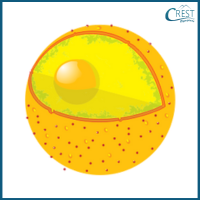1. Identify the organelle depicted below and choose the statements that accurately describe it.

I. It is responsible for controlling all cellular activities and contains the cell's genetic material.
II. It is involved in the synthesis of proteins and is the site of protein assembly.
III. It contains enzymes for breaking down foreign substances and cellular waste.
IV. It is present only in eukaryotic cells.
a) Only I
b) I and IV
c) II and III
d) I, III and IV
Answer: b) I and IV The organelle depicted in the picture is the nucleus.
I. The nucleus is responsible for controlling all cellular activities and contains the cell's genetic material (DNA), which carries the instructions for the cell's functions.
IV. The nucleus is present only in eukaryotic cells, which are cells with a true nucleus enclosed by a nuclear membrane. Prokaryotic cells lack a defined nucleus.
2. Fill in the blank:
A student observed a single-celled organism under a microscope and noticed that it constantly changes its shape and forms pseudopodia. This organism is most likely a(n) ________.
a) Plant cell
b) Animal cell
c) Unicellular organism
d) Multicellular organism
Answer: c) The observation of a single-celled organism constantly changing its shape and forming pseudopodia suggests that it is a unicellular organism. Plant and animal cells are not typically capable of such movement and shape changes on their own, and multicellular organisms are made up of more than one cell working together in a coordinated manner.
3. In the following question, you will find an assertion and a reason. Select the appropriate option that applies.
Assertion: Plant cells have a cell wall, while animal cells do not.
Reason: The cell wall provides structural support and protection to plant cells, whereas animal cells rely on other mechanisms for support.
a) Both the assertion and reason are correct, and the reason explains the assertion.
b) Both the assertion and reason are correct, but the reason does not explain the assertion.
c) The assertion is correct, but the reason is incorrect.
d) The assertion is incorrect, but the reason is correct.
Answer: a) Both the assertion and reason are correct, and the reason explains the assertion.
Plant cells do have a cell wall, which provides structural support and protection to the cell. On the other hand, animal cells lack a cell wall and rely on other mechanisms, such as the cytoskeleton and extracellular matrix, for support and protection. The reason provided accurately explains why the assertion is true.
4. Consider the following clues and identify the organelle 'X':
Clue 1: X is a membrane-bound organelle filled with digestive enzymes.
Clue 2: It is involved in the breakdown of cellular waste and foreign substances.
Clue 3: It is known as the "suicide sac" of the cell.
a) Lysosome
b) Mitochondria
c) Ribosome
d) Endoplasmic reticulum
Answer: a) Lysosome
The organelle 'X' described in the clues is the lysosome. Lysosomes are membrane-bound organelles that contain digestive enzymes, and they are responsible for breaking down cellular waste and foreign substances. They are often referred to as the "suicide sac" of the cell because they can also digest and recycle worn-out cell components.
5. A student prepared a slide of an onion peel and observed it under a microscope. What would the student expect to see in the cells of the onion peel?
a) Chloroplasts
b) Chromosome
c) Cell wall
d) Pseudopodia
Answer: c) When observing an onion peel under a microscope, the student would expect to see cell walls. Cell walls are a defining feature of plant cells, including those in an onion peel. They provide structural support and protection to plant cells. Chloroplasts are responsible for photosynthesis and are found in plant cells' green parts, but they are not present in onion peel cells. Chromosomes are found inside the nucleus of a cell, which may not be visible in an onion peel slide. Pseudopodia are temporary projections used by certain unicellular organisms for movement and are not found in plant cells like those in an onion peel.


